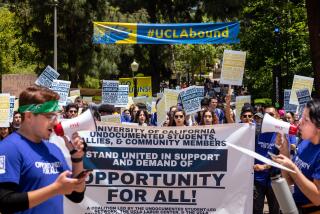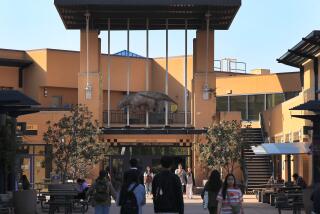International students are in panic mode. Can they get back to U.S. in time for fall term?

Ruhi Jha began attending UC Berkeley this year half a world away in her New Delhi home, struggling with social isolation and time zone differences that forced her online for midnight classes. She and her family contracted and survived COVID-19 last month, terrifying her as infections in India surged.
And now Jha is grappling with new anxieties faced by tens of thousands of international students enrolled at U.S. colleges and universities: Can they get back to campuses for the start of fall term?
International students are at a critical moment in their college education, panicked that huge backlogs for visas requests, shuttered consulates and bureaucratic rules that limit access to the U.S. may derail their long-awaited return to campus. The stakes are particularly high in California, the top destination for international students where USC and the 10-campus University of California system alone collectively educate more than 54,000 of the million-plus international students enrolled at U.S. colleges and universities.
The uncertainty has propelled higher education leaders across the country to plead to the Biden administration for faster action and more flexible rules for their international students, who bring not only their talent, but also highly coveted tuition revenue and billions of dollars to local economies.
International student enrollment had already declined nationwide by 11% between 2016 and 2019, a drop some attribute to the Trump administration’s hardline China stances and stricter visa policies. Pandemic shutdowns triggered an even greater plunge of 43% in new international students last year, according to the Institute of International Education, causing major financial losses at campuses and communities across the country.
“The potential of not remedying those concerns promptly is profound, with lingering effects,” UC President Michael V. Drake and all 10 campus chancellors recently wrote in a letter to Secretary of State Antony J. Blinken.
The letter noted that 16,000 UC international students remain outside the United States, with another 14,000 new students anticipated to enroll for fall 2021. Overall, the number of international students decreased by 6% last year over 2019, and UC leaders expressed the “urgent need for immediate action” to prevent further declines by clearing visa processing logjams.
State Department officials, in a May 5 response, told Drake that international students were a “priority” and affirmed support for the U.S. academic community and economy.
“We recognize the important contributions these students make to our college and university campuses, the positive impact they have on U.S. communities, and the rich benefits of academic cooperation in increasing cultural understanding, furthering research, and knowledge, and supporting United States diplomacy,” the response said.
U.S. officials recently took major steps to ease the crunch. In late April, they lifted pandemic-related travel restrictions on students with valid visas from China, Brazil, Iran and South Africa, among other countries, as long as their academic programs begin on or after Aug. 1. They subsequently added exceptions for students from India despite the current COVID-19 surge there. They also allowed waivers of in-person visa interviews for students renewing their documents.
And, in a key advance, the U.S. embassy and consulates in China reopened student visa services this month for the first time in more than a year, assigning hundreds of staff members to process what they anticipate will be 2,000 applications a day.
China is by far the largest source of international students in the United States, providing more than one-third of those at U.S. colleges and universities and more than half at UC and USC. But the pandemic shutdown triggered an 87% drop in visas granted to international students overall last year, with those to students from China plummeting to 943 from an average of 90,000 annually in previous years, according to research by Gaurav Khanna, a UC San Diego assistant professor or economics.
Despite these recent breakthroughs, problems remain. At UC San Diego, which educates the largest number of international students among UC campuses, as many as 25% of 8,400 students are still outside the country, said Dulce Dorado, director of the International Students & Programs Office. Some of them are facing problems getting visa appointments, confusion over travel rules, exorbitant airfare and access to flight reservations to California, she said.
“There’s just a lot of anxiety and concern from our students about whether they’re going to be able to return in the fall,” Dorado said. “But we’re doing everything we can to advocate for them. It is imperative that universities attract and retain the top students and faculty from within the United States and around the globe. Their contributions are evident in practically every sector of our society and bring us discoveries, innovation, artistic creativity, and economic vibrancy.”

Ivor Emmanuel, director of the UC Berkeley International Office, called the relaxed travel rules a “game-changer” that will allow a significant number of students to return to campus by fall. More than half of Berkeley’s 5,892 international students remain outside the United States, he said.
But Emmanuel noted that a Trump administration policy banning entry of Chinese graduate students and researchers affiliated with universities linked to the People’s Liberation Army was still in place.
Students from Iran must travel to other countries to apply for visas because the U.S. does not maintain an embassy in the Persian nation.
Anthony Bailey, USC vice president for strategic and global initiatives, said some of the university’s Iranian students are reporting slow progress in securing visas. But he was hopeful for a fall return of most international students.
Fewer than a third of USC’s 10,402 students enrolled in degree programs were thought to be outside the country, he said, because most of them are graduate students who never left.
“With all of the difficulties of the past year, we can now see the State Department focusing on and prioritizing international students and COVID cases dropping in most places,” he said.
The American Council on Education and other leading higher education associations, however, have asked U.S. officials for additional changes: priority on visa processing for students and scholars, waivers for in-person visa interviews for new students and allowing video sessions.
They also asked that travel restrictions on faculty and researchers be lifted, along with rules that prevent some students from returning to the U.S. for academic or work training programs that begin before Aug. 1.
Meanwhile, many students remain on edge. Aimee Wang, a UC Santa Barbara senior majoring in sociology, has been caught in a bureaucratic snarl trying to renew her visa from her Shanghai home. She’s planning to fly to Singapore to do so but is still nervous about the prospects of success there.
In a year filled with anxieties, this was just the latest. Wang said moving back into her parents’ home after eight years away — she also attended a U.S. high school — was jarring. She desperately missed her friends and her student leadership work. She had to avoid expressing her outspoken progressive political views and was stressed about keeping her grades up across time zones — one class began at 3 a.m. — and getting into graduate school.
To improve her mental health, she said, she repeatedly watched a talk by Michelle Obama on never giving up.
Jha said she was relieved to hear about the student travel ban exception for India. But she still needs a student visa and can’t get one because U.S. consulates that process them remain shuttered in her country.
She also needs a COVID-19 vaccination, which UC expects to require by fall, but trying to land an appointment for one in the world’s second most populous country amid a devastating outbreak so far has been frustrating and fruitless.
“I don’t think I’ve ever been in such a stressful situation in my life,” said Jha, 20, in an interview from India. “There have been quite a few moments of tears, but you just have to stay positive and scrape through whatever life is showing you.”
More to Read
Sign up for Essential California
The most important California stories and recommendations in your inbox every morning.
You may occasionally receive promotional content from the Los Angeles Times.











